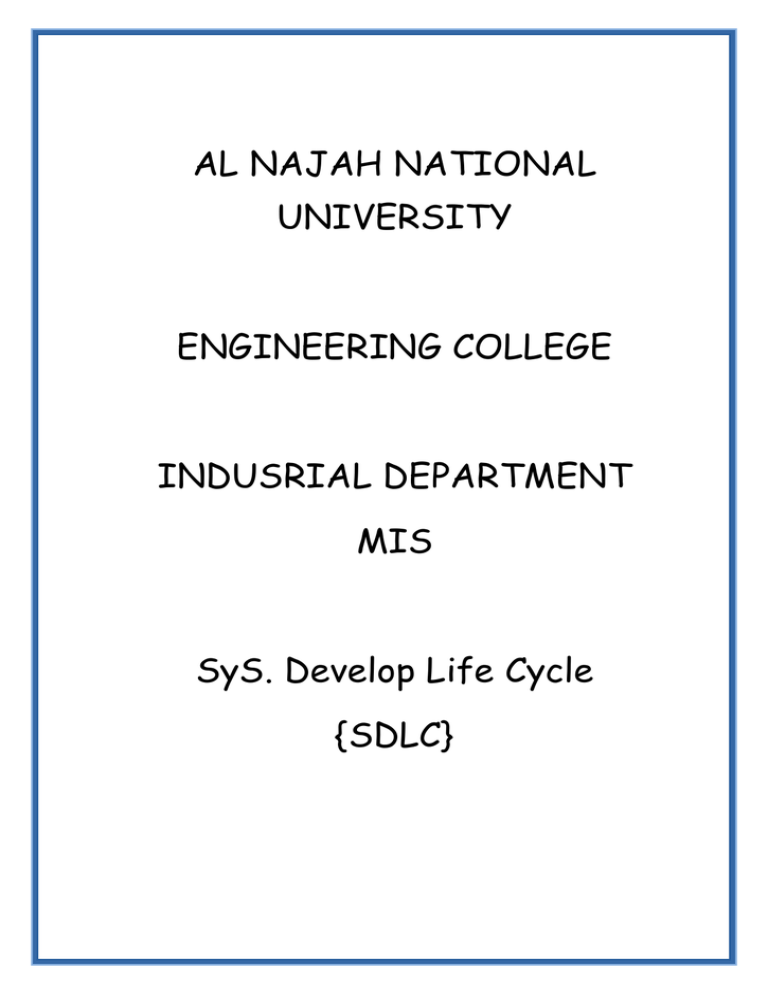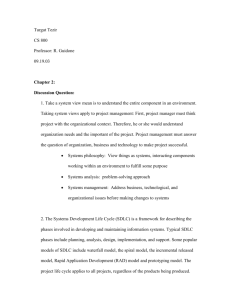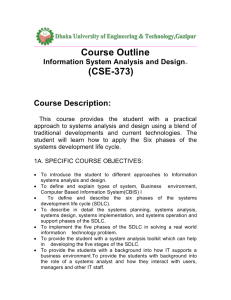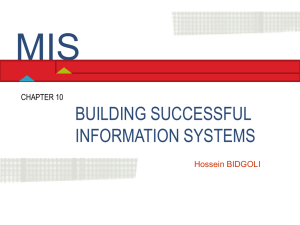
AL NAJAH NATIONAL
UNIVERSITY
ENGINEERING COLLEGE
INDUSRIAL DEPARTMENT
MIS
SyS. Develop Life Cycle
{SDLC}
The SDLC
can be defined as the formalized process of developing
information systems through the following successive phases:
Each phase of the model consists of sub phases and each stage must be
completed to a great extent before moving to the next one.
The segmentation of the SDLC into logical phases aims at facilitating
information system development by focusing on one manageable subset of the
whole project at a time.
The term“ life cycle” can have various interpretations according to the
context in which it is used. Basically, it denotes the fundamental phases or
stages of the evolution a product or activity passes through from its creation
to its maturity and retirement. There are numerous variations of information
system development methodologies based on the life cycle concept, such as
the waterfall or the V-shaped model.
Figure 1 The conventional SDLC model. [Adapted from Daniels, A., and Yeates, D. A. (1971). Training in Systems
Analysis, 2nd ed. London: Pitman.]
PHASES OF THE SDLC
A. Feasibility Study
The feasibility study investigates existing systems in view of new requirements
and considers alternative solutions.
System analysts determine whether an identified need for a new system or
application is necessary for the organization, cost effective, and compatible
with the organization’s IT architecture and business strategy.
This preliminary project feasibility study contains the following aspects:
Legal
feasibility
Examines whether the proposed system
conforms to legal requirements.
Economic
feasibility
Is concerned with the availability and cost
effectiveness of resources needed to complete
the project.
Technical
feasibility:
Examines whether the new system can be
developed and implemented using existing
technology.
Strategic
feasibility
Org. and
social
feasibility:
Operational
feasibility
Schedule
feasibility
Examines whether the recommended system
fits into the strategic business and information
technology plan of the organization
Examines whether the system is acceptable
for the organization and its people at all levels
Pertains to the compatibility between
organizational procedures, existing systems, and
operations of the new system
Examines whether the system can be developed
on time and identifies alternative options
It should be noted that a complete feasibility study is not possible at this
stage, since the analysis phase has not even started and the full scale of the
project is not yet known.
For this reason some authors place this activity after the system
analysis phase. Obviously, in practice, some overlapping between the three first
phases of the SDLC is inevitable.
B. System Investigation
System investigation is thorough examination of the functional
requirements, the performance and restrictions of the existing system .
If there is one currently operating, and the requirements of the intended
system…. At this stage, a more detailed analysis will be conducted, taking into
account data types, volumes, and transactions, which the new system needs to
process.
The requirements documentation, that is the recording of the requirements
in any form, such as a computer file or a document, ensures that all people
involved in the development project take into account user information needs
and other requirements, such as system friendliness and ease-of-use.
Tools and Techniques
The achievement of good requirements definition is essential for
designing and building useful information systems.
To this end the analysis team uses a number of techniques, such as
observation, document study, interviewing, questionnaires, and prototyping
Observation: One technique for collecting data on a function or business
process is to observe crucial data and information flow pertaining to this
function or process.
Document Study: The search and study of documents may provide
useful information and identify existent problems.
Interviewing: Interviews can be fairly unstructured in the beginning or
semi structured and structured during the final phase of interviewing the
system users.
Questionnaires: Questionnaires are used extensively for collecting data
from a large number of people and for post implementation system audits.
Prototyping: Prototypes, that is, working models of systems to be
developed, provide a useful tool for identifying system and software
specifications.
System Analysis
At this phase, the information gathered during system investigation
is meticulously examined and the current system is analyzed in detail in
order to formally determine the functional requirements of the new
system.
The requirements analysis/definition phase forms a fundamental part of
the SDLC methodology.
Therefore, system developers need to make sure that requirements have
been defined as comprehensively and precisely as possible.
System analysis is the investigation of a problem situation, which
involves rigorous understanding and description of the existing system
leading to the identification and recording of the characteristics of the
new, intended, information system.
The objective of the analysis of existing information systems is to
identify whether and to what extent the system is well defined and
successfully operating and eventually propose how the new system will
improve upon the current one.
The final product of system analysis is a report which includes the
following:
scope of study,
problems identified with current systems,
user requirements specification,
resource availability,
and recommendation as to whether the project should be
continued in light of the analysis findings.
System Design
System design provides the solution to a problem.
In this phase, alternative technical solutions are examined and the
specification of the new system in terms of hardware, software, human
resources, and procedures is provided.
This phase consists of two basic sub-phases.
The first one is the logical design of the system, that is, how the
system fits the requirements.
In some SDLC models, this may overlap to some extent with analysis
performed during the system analysis phase.
The second one examines the physical design of the system consisting
of hardware, software, file, database, and program specifications.
The basic activities performed in the system design
phase are related to the following:
• Human-computer
interface design:
The Human- Computer Interface (HCI) is
the means by which users interact with
the system. Thus, the design of the HCI,
the visible part of the system to the
users, is an important design activity,
which is based upon the logical data flow
analysis.
• I/O design:
• Software design:
System analysts/designers determine
the content and the format of the
information processed by the system,
considering user requirements and
technical issues, such as access
controls, output mediums, and storage
devices. The content and the means of
data input to the new system are also
designed. Software tools are used to
facilitate I/O design.
If a need for developing new
software applications was identified
during the analysis phase, then software
engineering takes place. Software
engineering can be defined as the
structured process for developing quality
and reliable software programs by using a
set of appropriate techniques and tools.
Alternative solutions are the procurement
of ready-made application packages or
the outsourcing of the whole or part of
the information system function.
System Implementation
System implementation is the activity of installing according to
specifications and delivering into operation a computer system, which was
either developed by the organization or purchased from a third party.
According to the traditional SDLC model system implementation
involves the following:
Testing
Delivering the system
into operational use
Software
development or
programming
Documenting
1. Programming
During this phase, software engineers construct the programs, which
might have been designed in the previous
phase.
2. System and Software Testing
The testing sub phase is very important in determining
the quality and the performance of the developed
information system.
3. System Documentation
System documentation is usually generated automatically
by using computer aided software and system engineering
tools.
4. Going Live
After successful testing, the system is finally installed and
put into operation. This is a complex activity as a range
of organizational, behavioral, and technical issues are
still involved.
F. Review and Maintenance
The post implementation audit and review activities are important in
order to determine the usefulness of the system, the required
modifications and the extent at which the system meets the project
objectives.
There are no generally accepted measures that can be used to evaluate
the performance of the implemented system.
The new system should be constantly monitored by
developers, users, and management to ensure it performs
according to intended functionality and meets
expectations and standard
Conclusion
System analysis and design is a systematic approach to
identifying problems, opportunities and objectives to analyze the
information flows in organizations, and to designing computerized
information systems to solve the problems. The framework for this
systematic approach is provided in what is called the system
development life cycle (SDLC), This cycle can be divided into many
stages as we considered.
MY RESOURCES
1) CERN Engineering data management service [online]. Ženeva.
Dostupné z WWW: <cedar.web.cern.ch/CEDAR/glossary.html>
2) Process Advantage Technology [online]. San Francisco. Dostupné
z WWW: http://go.microsoft.com/fwlink/?LinkId=69157
3) Hoffer, J.: Modern system analysis and design, fourth edition,
Pearson Prentice Hall, New Jersey, 2002,
4) Saldarini, R.: Analysis and design of business information
systems, Macmillan PC, New York, 1990
ISBN 0-02-946403-x
Prepared by: NADA SWEEDAN
Delivered to: Dr. MAHER ARAFAT










